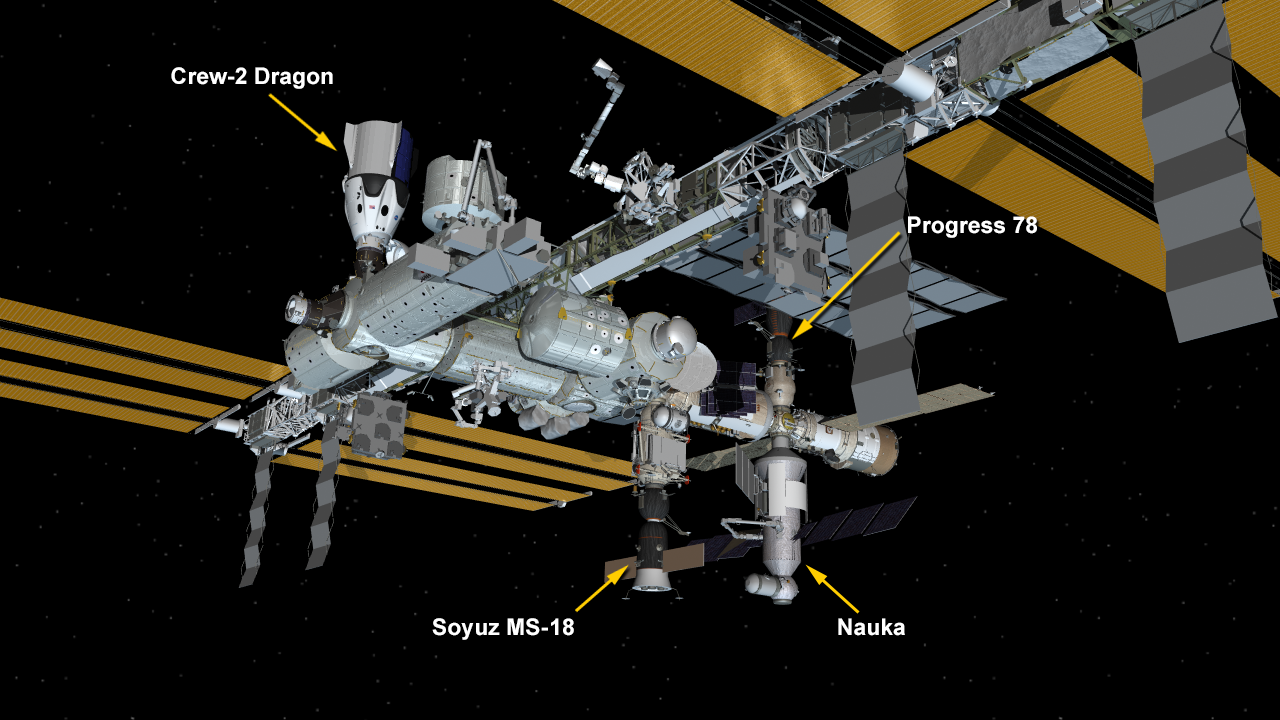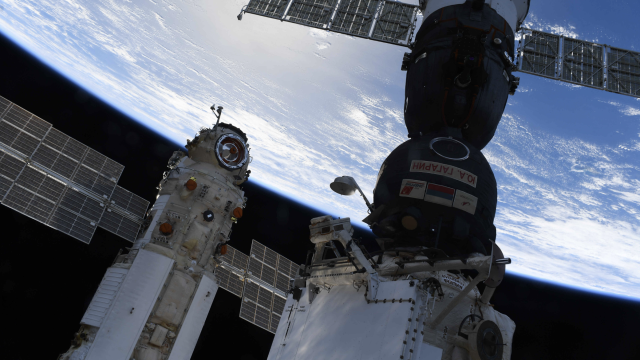A NASA flight director has provided new details about last week’s scary incident in orbit, in which a freshly docked Russian module inadvertently fired its thrusters, causing the International Space Station to roll backwards.
The incident happened on Thursday, July 29, some three hours after Russia’s Nauka module docked to the space station. As Russian crew members worked to integrate the newly arrived section, Nauka’s thrusters began to fire, causing the ISS to roll backwards. Russian flight controllers eventually re-gained control, but, for a 47-minute span, the situation looked dicey.
At a press conference held later that day, NASA said the space station shifted by around 45 degrees. “That’s been a little incorrectly reported,” Zebulon Scoville, the NASA flight director in charge at the time, told the New York Times. The actual figure, he said, is closer to 540 degrees, which means the ISS performed 1.5 backflips, in an impromptu performance that would make an Olympic athlete jealous. When the ISS stopped spinning, it was fully upside down, requiring a 180-degree forward flip to regain the outpost’s original position, as the New York Times reports.
Lead MLM Flight Director Greg Whitney and I split the shift today. Never have I ever: 1)been prouder of the team that sits in MCC and lives on @Space_Station, 2)had to declare a spacecraft emergency until now, 3)been so happy to see all solar arrays + radiators still attached. https://t.co/Bmox4WVZsn
— Zebulon Scoville (@Explorer_Flight) July 29, 2021
Concerned, I reached out to NASA to inquire about the discrepancy, and to confirm the figures provided by Scoville.
In an email, a NASA spokesperson said the “initial value reported by flight controllers, which was called up to the station astronauts in real time and shared via NASA tweets/live coverage, was 45 degrees.” This value, according to the spokesperson, was being reported as the event was still unfolding, that is, as Nauka, also known as the Russian Multipurpose Laboratory Module (MLM), was still firing its thrusters and as flight controllers were continuing to change the station’s orientation. The value offered by Scoville — 540 degrees — was “confirmed only after the post-event analysis was complete,” the spokesperson explained.
NASA maintains that the crew of seven was never in any danger, but as Harvard-Smithsonian astrophysicist Jonathan McDowell told me last week, this was “one of the more serious incidents in the 24-year-history of the ISS.” The loss of attitude control, he said, “risks breakup” of the entire structure.

Scoville wasn’t scheduled to work on Thursday, but, following the docking of Nauka, he was asked to fill in for flight director Gregory Whitney, who had to attend a meeting. At 12:34 p.m. EDT, Scoville noticed an error message having to do with the ISS’s four gyroscopes, which maintain the station’s attitude control. As NYT’s Kenneth Chang reports:
“And so at first I was like, ‘Oh, is this a false indication?’” Mr. Scoville said. “And then I looked up at the video monitors and saw all the ice and thruster firings. This is no kidding. A real event. So let’s get to it. You get about half a breath of ‘Oh, geez, what now?’ and then you kind of push that down and just work the problem.”
Nauka’s thrusters had started firing, trying to pull away from a space station it was securely docked to.
Worse, there was no way to turn them off.
His counterparts at the mission control in Russia told him that Nauka was configured so that it could receive commands directly only from a ground station in Russia. The next pass over Russia was 70 minutes away.
Nauka, attached to the ISS underbelly, began to pull the aft section down, causing it to perform a backflip at the rate of 0.56 degrees per second. This rate of spin wasn’t fast enough for the crew to notice, but it was potentially enough to cause structural damage and to point the station’s antennas away from their intended targets. And indeed, ground controllers lost communication on two instances, once for four minutes and once for seven minutes, according to the NYT. The station’s solar arrays and radiators were locked to prevent damage.
Unable to disable Nauka’s thrusters, Russian controllers counteracted the momentum by firing thrusters attached to the Zvezda Service Module. Fearing this might not be enough, they also fired thrusters on a Progress cargo ship docked to the station. This 15-minute tug-of-war finally stopped when Nauka’s thrusters suddenly cut out, for reasons unknown (it probably ran out of fuel). With attitude control regained, the flight controllers were able to right the ship. No further issues have been reported, and the Russian crew is now busy at work integrating the newly arrived 21 T module.
The video below shows the crew opening the hatch to the new module, followed by a tour of Nauka itself.
That the station rolled 540 degrees rather than 45 degrees is not a big deal, according to NASA.
“The greater degree of rotation doesn’t change the outcome — all other station systems responded normally to the event and resumed regular operations once attitude control was regained,” explained the NASA spokesperson in an email. “Most importantly, the maximum rate at which the attitude change occurred,” the rate of approximately 0.5 degrees per second, “was well within the design limits of station systems and slow enough to go unnoticed by the crew members on board.”
Writing in a tweet, Scoville said it was the first time he ever had to declare a spacecraft emergency and that he was never so happy to see all the solar arrays and radiators still attached. Vladimir Solovyov, flight director of the Russian segment of the ISS, said a “short-term software failure” was to blame for the incident, in which a “direct command was mistakenly implemented to turn on the module’s engines for withdrawal, which led to some modification of the orientation of the complex as a whole.”
The mishap forced NASA and Boeing to delay the launch of the CST-100 Starliner to August 3. A technical problem caused yet another delay today, and the launch is now scheduled for August 5, with NASA coverage beginning at 2:57 a.m. AEST.
